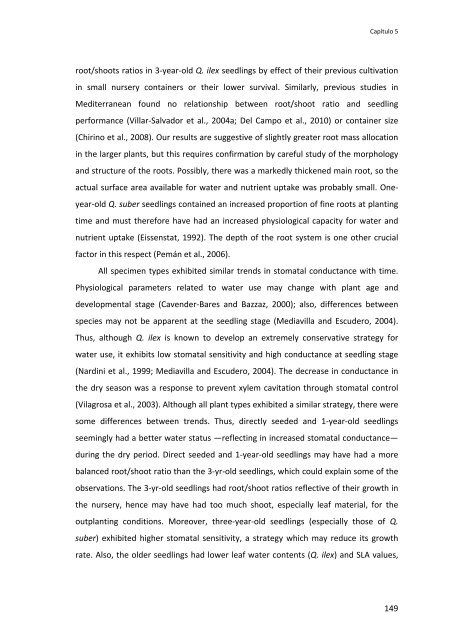Establecimiento de cuatro especies de Quercus en el sur de la ...
Establecimiento de cuatro especies de Quercus en el sur de la ...
Establecimiento de cuatro especies de Quercus en el sur de la ...
Create successful ePaper yourself
Turn your PDF publications into a flip-book with our unique Google optimized e-Paper software.
Capítulo 5<br />
root/shoots ratios in 3‐year‐old Q. ilex seedlings by effect of their previous cultivation<br />
in small nursery containers or their lower <strong>sur</strong>vival. Simi<strong>la</strong>rly, previous studies in<br />
Mediterranean found no r<strong>el</strong>ationship betwe<strong>en</strong> root/shoot ratio and seedling<br />
performance (Vil<strong>la</strong>r‐Salvador et al., 2004a; D<strong>el</strong> Campo et al., 2010) or container size<br />
(Chirino et al., 2008). Our results are suggestive of slightly greater root mass allocation<br />
in the <strong>la</strong>rger p<strong>la</strong>nts, but this requires confirmation by careful study of the morphology<br />
and structure of the roots. Possibly, there was a markedly thick<strong>en</strong>ed main root, so the<br />
actual <strong>sur</strong>face area avai<strong>la</strong>ble for water and nutri<strong>en</strong>t uptake was probably small. Oneyear‐old<br />
Q. suber seedlings contained an increased proportion of fine roots at p<strong>la</strong>nting<br />
time and must therefore have had an increased physiological capacity for water and<br />
nutri<strong>en</strong>t uptake (Eiss<strong>en</strong>stat, 1992). The <strong>de</strong>pth of the root system is one other crucial<br />
factor in this respect (Pemán et al., 2006).<br />
All specim<strong>en</strong> types exhibited simi<strong>la</strong>r tr<strong>en</strong>ds in stomatal conductance with time.<br />
Physiological parameters r<strong>el</strong>ated to water use may change with p<strong>la</strong>nt age and<br />
<strong>de</strong>v<strong>el</strong>opm<strong>en</strong>tal stage (Cav<strong>en</strong><strong>de</strong>r‐Bares and Bazzaz, 2000); also, differ<strong>en</strong>ces betwe<strong>en</strong><br />
species may not be appar<strong>en</strong>t at the seedling stage (Mediavil<strong>la</strong> and Escu<strong>de</strong>ro, 2004).<br />
Thus, although Q. ilex is known to <strong>de</strong>v<strong>el</strong>op an extrem<strong>el</strong>y conservative strategy for<br />
water use, it exhibits low stomatal s<strong>en</strong>sitivity and high conductance at seedling stage<br />
(Nardini et al., 1999; Mediavil<strong>la</strong> and Escu<strong>de</strong>ro, 2004). The <strong>de</strong>crease in conductance in<br />
the dry season was a response to prev<strong>en</strong>t xylem cavitation through stomatal control<br />
(Vi<strong>la</strong>grosa et al., 2003). Although all p<strong>la</strong>nt types exhibited a simi<strong>la</strong>r strategy, there were<br />
some differ<strong>en</strong>ces betwe<strong>en</strong> tr<strong>en</strong>ds. Thus, directly see<strong>de</strong>d and 1‐year‐old seedlings<br />
seemingly had a better water status —reflecting in increased stomatal conductance—<br />
during the dry period. Direct see<strong>de</strong>d and 1‐year‐old seedlings may have had a more<br />
ba<strong>la</strong>nced root/shoot ratio than the 3‐yr‐old seedlings, which could exp<strong>la</strong>in some of the<br />
observations. The 3‐yr‐old seedlings had root/shoot ratios reflective of their growth in<br />
the nursery, h<strong>en</strong>ce may have had too much shoot, especially leaf material, for the<br />
outp<strong>la</strong>nting conditions. Moreover, three‐year‐old seedlings (especially those of Q.<br />
suber) exhibited higher stomatal s<strong>en</strong>sitivity, a strategy which may reduce its growth<br />
rate. Also, the ol<strong>de</strong>r seedlings had lower leaf water cont<strong>en</strong>ts (Q. ilex) and SLA values,<br />
149

















